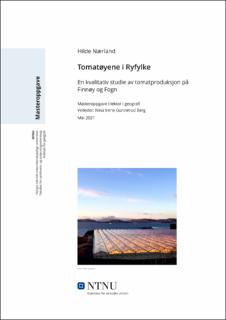| dc.contributor.advisor | Berg, Nina Irene Gunnerud | |
| dc.contributor.author | Nærland, Hilde | |
| dc.date.accessioned | 2021-09-28T17:56:36Z | |
| dc.date.available | 2021-09-28T17:56:36Z | |
| dc.date.issued | 2021 | |
| dc.identifier | no.ntnu:inspera:80618201:13225043 | |
| dc.identifier.uri | https://hdl.handle.net/11250/2785233 | |
| dc.description.abstract | Nærland, H. (2021). Tomatøyene i Ryfylke – en kvalitativ studie av tomatproduksjon på Finnøy og Fogn. Masteroppgave for lektorutdanning i geografi. Institutt for geografi. Norges teknisk-naturvitenskapelige universitet, Trondheim.
Denne kvalitative studien utforsker hvilke entreprenørskapsprosesser som har medvirket til at Finnøy og Fogn har fått så omfattende produksjon av tomater. De første tomatplantene ble plantet under glasstak allerede i 1928, og næringen har siden den gang vokst fra å være en tilleggsnæring som fantes på annenhver gård, til å bli en viktig næring for øyene. I dag står gamle Finnøy kommune for omtrent en tredjedel av Norges tomatproduksjon. For å belyse tematikken har jeg intervjuet seks tomatprodusenter, og resultatene baserer seg på deres personlige erfaringer og opplevelser av næringen. I det teoretiske rammeverket tar jeg for meg entreprenørskap og innovasjon, stedsperspektiver, nettverksteori, og teori om kunnskapstyper og læringsprosesser.
Resultatene fra studien viser at fellesskapet på øyene har hatt mye å si for hvordan næringen har utviklet seg. Et bredt faglig nettverk har også vært viktig for at tomatprodusentene har våget å satse på næringen, og gode konsulenter har blant annet medvirket til dette. Gjennom dette faglige nettverket og det sosiale fellesskapet på øyene, har tomatprodusentene tilegnet seg ulike former for kunnskap, og dette har de gjort gjennom ulike læringsprosesser. Det kommer frem at det er komplekse prosesser i samfunnet som har skapt den næringen som er på Finnøy og Fogn i dag. | |
| dc.description.abstract | Nærland, H. (2021). Tomatøyene i Ryfylke – en kvalitativ studie av tomatproduksjon på Finnøy og Fogn. Master thesis in teacher program in Geography. Department of Geography. Norwegian University of Science and Technology, Trondheim.
This qualitative study explores the entrepreneurial processes that have contributed to Finnøy and Fogn having such extensive production of tomatoes. The first tomato plants were planted inside a greenhouse as early as 1928, and the industry has since grown to be an important industry for the islands. Today, old Finnøy municipality accounts for about a third of the tomato production in Norway. To shed light on the topic, I have interviewed six tomato producers, and the results are based on their personal experiences of the industry. The theoretical framework consists of entrepreneurship and innovation, place perspectives, network theory, and theory of different knowledge types and learning processes.
The results from the study show that the community on the islands has had a big impact on how the industry has developed over the years. A broad professional network has also been important for the tomato producers, and good consultants have, among others, contributed to this. Through this professional network and the social community on the islands, the tomato producers have acquired various forms of knowledge, and they have done this through various learning processes. It appears that there are complex processes in the society that have created the industry that is on Finnøy and Fogn today. | |
| dc.language | nob | |
| dc.publisher | NTNU | |
| dc.title | Tomatøyene i Ryfylke - en kvalitativ studie av tomatproduksjon på Finnøy og Fogn | |
| dc.type | Master thesis | |
